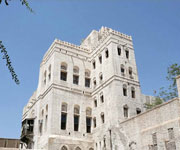Zabid's domestic and military architecture and its urban plan make it an outstanding archaeological and historical site. Besides being the capital of Yemen from the 13th to the 15th century, the city played an important role in the Arab and Muslim world for many centuries because of its Islamic university. Historic Town of Zabid is one of the coastal towns in Tehama area west of Yemen, sitting on a rise above the river junction and the fertile flood plain. It is a circular fortified town with four remaining gates, which was supplied with water by extensive canals. It was already flourishing when Islam was established in the region in the 7th century. Its development is due to Ibn Ziyad (the founder of the Zyadite dynasty), who was sent to the region by the Caliph al-Mamun in 820 AD to quell a rebellion.

Continent: Asia
Country: Yemen
Category: Danger List
Criterion: (II)(IV) (VI)
Date of Inscription: 1993
Highest mosques in Yemen
The core of the town is its first mosque, Asair. The Great Mosque lies to the west of the town to which spread the souq. Zabid has the highest concentration of mosques in Yemen, some 86 in all, mainly simple brick structures but some with elaborate carved brick and stucco decoration. Fourteen of these date to the Rasulid period - all of them madrasas - and are the largest group of buildings from this period in Yemen.
 |
| Zabid Historic Building |










0 comments:
Post a Comment